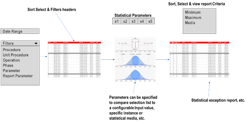Understanding your process performance starts with having unambiguous data that is contextualized. This data provides information that quantifies and qualifies the different aspects that provide insight into the overall system performance. This data ends up in a repository and gets analyzed to produce actionable information and these reports may look at different aspects of the activities required to make products or to clean the equipment. By looking at the process from the ISA 88 and ISA95 point of view, we are able to provide additional context to the information for which the basic activities are reporting.
Additional information may be added to provide more insight into the activities related to:
- Quality – (amounts, tolerances, durations, temperatures, lethality, etc.)
- Cost — (materials, energy, personnel, equipment, etc.)
- Material information – (lot ID, material properties, storage locations, etc.)
- Personnel – (who is performing tasks, signoffs, etc.)
- Energy – (transport, heat/cool, mix, etc.)
- Equipment – (raw material source, equipment utilization, portable equipment information.)
…as well as other aspects that can be used to make informed decisions.
As an example, a traditional material dosing phase will have the following tags to specify and capture parameters (recipe specified) and report parameter values (process variables).
Parameters:
- Amount set-point
- Tolerance set-point
Report Parameters:
- Actual amount
- Actual tolerance
Additional parameters for a dosing phase can include even more information like the following:
- Dosing duration
- Maximum flow rate
- Minimum flow rate
- Average flow rate
- Out of tolerance notification
- Material cost of replacement
- Material total cost
- Lot ID
- Material source
- Material arbitration delay duration
- Operator confirmation duration
- Equipment failure
- Equipment failure duration
- Transport energy usage
- Transport energy rate
- Transport cost
- Total cost of material dosed
- Etc.
These concepts can be added to the different phases in the process like:
- Heat
- Cool
- Pressurize
- Transfer
- Manual prompts
- Mixing
- Etc.
To provide users better insight as to how the process equipment and personnel are performing. Since this information is captured at the basic level of the procedural activities model, it is modular and will be applicable to any procedure being performed with the plant equipment.
The information of these phases can be combined by differing the report values to the operation, unit procedure, and procedure level. This means that the different stake holders of the process can immediately obtain information for each batch performed.
Using analytics, the different batches can be compared to determine the true performance of the process equipment as well as the personnel.
To provide a better insight into the process equipment and personnel performance, additional report parameter values can be added to new and existent phases.
Randy Otto is CEO of ECS Solutions, a certified member of the Control System Integrators Association (CSIA). For more information about ECS Solutions, visit its profile on the CSIA Industrial Automation Exchange.
Leaders relevant to this article:


